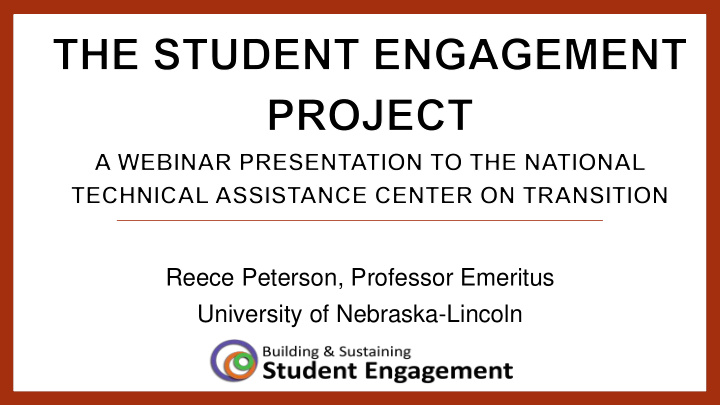



Reece Peterson, Professor Emeritus University of Nebraska-Lincoln
Today’s • To explain the purposes of the Goals project. • To explain the nature of the materials available through “The Student Engagement Project.” • To explain how to find and use these materials.
Purposes of the Project • Provide strategies to educators to • Reduce exclusionary discipline/improve student behavior. • Reduce student dropout; increase graduation • Materials useful for two primary purposes • School Improvement Planning/ ILCD (Nebraska SpEd School Improvement) • Individual Student Planning / Student Assistance Teams • Monitor & provide assistance with regard to use of physical restraint and seclusion procedures.
Principles Underlying the Goals • Accessibility of information to educators • Employ a Multi-Tiered System of Support Tier 1 (MTSS) to explain use of Strategies (Insure compatibility to PBIS). • Identify and summarize research to insure educators are aware of the evidence base Tier 3 for strategies. Tier 2 • Identify where educators can get additional information or resources.
Creating Strategy Briefs Each identifies: • The Tier of (& other documents) Intervention. • The evidence supporting the • We wanted strategies- not just “activities” intervention • Example- Parent involvement • Resources for more information • Variety of specific activities could be included • This allows tailoring to local school culture & needs • Identify as many strategies as possible- Tier 1 Tier 3 • Conduct a literature search • Draft a document using a basic structure • Intro; what it is; research & literature summary Tier 2 • Outside reviewers employed
Documents Created • Creation of documents • Two topical briefs • Schoolwide behavior screening (9 pages) • Examples of Behavior Screeners (6 pages) • Dropout Screening & Early Warning Systems (15 pages) • 42 Strategy briefs (4-14 pages) • 8 Resource briefs (5-10 pages) • 2 more almost ready • 4 additional in various stages – more possible. • 12 Program documents (4-8 pages)
Physical Restraint & Seclusion Addressing: • Analysis of laws, policies and court decisions • Survey of content of crisis training programs • Analysis of issues of safety, imminent danger, ethical issues. • Possible survey of district policies and training
Strategies are organized in a multi-tiered model Multi-tier system of support Tier 1/Primary ● Tier 1 - Prevention ● Tier 2 – Early Tier 3 Intensive Intervention Intervention ● Tier 3 – Intensive Tier 2 Early Intervention Invervention Materials available at: k12engagement.unl.edu
Documents • Are free! • PDF format to download, share & print. • Accessible any time on the website. • Indexed in several ways on the website
Examples of Tier 1 Strategies • Reinforcement for Positive Behavior • Before & After School Programs • School Values & Expectations • Bullying Prevention & Intervention • Service Learning & Community • Conflict De-escalation Learning • Middle to HS Transition Planning • Social Skills Instruction • Parent & Family Involvement • School Climate • Postsecondary Transition Planning And more....
School Climate “Attitude” or “Mood” of the school • Different from school culture o Identified as a crucial step toward • school improvement A positive school climate • Improves academics o Decreases risky behavior & bullying o Decreases teacher burnout o • (Thapa, Cohen, Guffey, & Higgins-D’Alessandro, 2013) Process of improvement •
Examples of Tier 2 Strategies Restitution Academic Supports & Tutoring Restorative Practices Anger Management Sleep and School Detention Truancy Reduction Individual Behavior Plans & FBA Wraparound In-School Suspension Youth Courts Mentoring And more… Peer Mediation *Some are applicable at the tier one or three levels
Conflict De-escalation Broad term to describe a variety of • techniques that reduce tension between two individuals or two groups of people • Conflict Cycle (Colvin, 2015) Interrupt the conflict cycle o Validate student feelings Phases of Acting-Out Cycle • Keep students in calm phase o Provide positive reinforcement
Program Check-In/Check-Out • Monitor student progress • Additional structure in day • Positive daily contact 1-10 minutes, twice a day o • Discuss: daily events, behavioral goals, & strategies • Reinforces positive behaviors & academic responsibility • Behavioral chart/checklist • May reflect PBIS school expectations
Tier 3 Strategies • Academic Supports & Tutoring • Alternative Schooling • Restitution • Conflict De-Escalation • Restorative Practices • Discipline Recovery • Wraparound • Dropout Recovery • Youth Courts • Family Group Conferencing • Program Check & Connect • Individual Behavior Plans and • And more... Functional Behavioral Assessment *Some are applicable also at the tier one or two levels
Restorative Practices • Problem-solving approach to help students learn how to manage their behavior • Focus is not on punishment, but on addressing harm, healing relationships, and helping students become better people by encouraging them to come up with a plan to right their wrongs
Questions? For more information: ● http://k12engagement.unl.edu ● Facebook: Student Engagement Project ● Twitter: @k12engagement
Recommend
More recommend